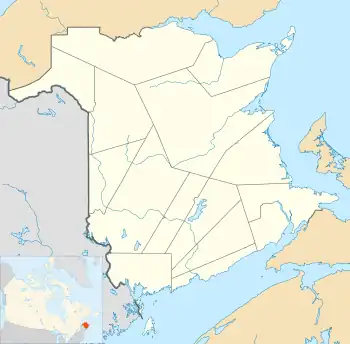
Pabineau Falls is a settlement in New Brunswick, Canada. It is the administrative office of the Pabineau Mi'kmaq First Nation band government. The Pabineau First Nation is a small Mi’gmaq community situated approximately 8 kilometers south of the City of Bathurst, New Brunswick, with 280 registered band members and a land base of 1,053 acres. The Pabineau First Nation's average on-reserve population is approximately 200 individuals.[1] The falls themselves are a set of small rapids on the Nepisiguit River, popular with kayakers.
New Brunswick's 911 system uses Pabineau Falls only for the area north of the reserve; addresses within the reserve are listed as Pabineau First Nation.[2]
History
The Nepisiguit River formed during the Devonian Period, with the final closure of the Iapetus and Rheic Oceans. Material from the ocean crust rose upward and solidified near the surface as granite rocks. An age of 397 million years has been calculated for the Pabineau Falls Granite based on radiometric data. William Logan first described the granite in 1863.[3]
Powwow
The Annual Powwow is held at the "Flying Eagle Memorial Pow-wow Grounds" the first weekend of July (Saturday and Sunday). It is located on the Nepisiguit River, upriver from Bathurst.The Powwow honors the Mi’gmag heritage with traditional Aboriginal dancing, singing, arts, crafts, foods, and contemporary entertainment. Powwows are considered to be both sacred and a social event, where Aboriginal families renew their bonds and celebrate their ancestral beliefs and traditions. There is no charge for admission, parking, or camping space, and visitors are welcome.[4]
Notable people
See also
References
- ↑ "Demographics". Pabineau First Nation. Retrieved 21 December 2017.
- ↑ "Master Street Address Guide". Government of New Brunswick. Retrieved 24 December 2021.
- ↑ "Pabineau Falls, Bathurst". New Brunswick Museum. Retrieved 21 December 2017.
- ↑ pabineaufirstnation.ca: "Pow Wow"
47°30′22″N 65°40′46″W / 47.5062°N 65.679402°W